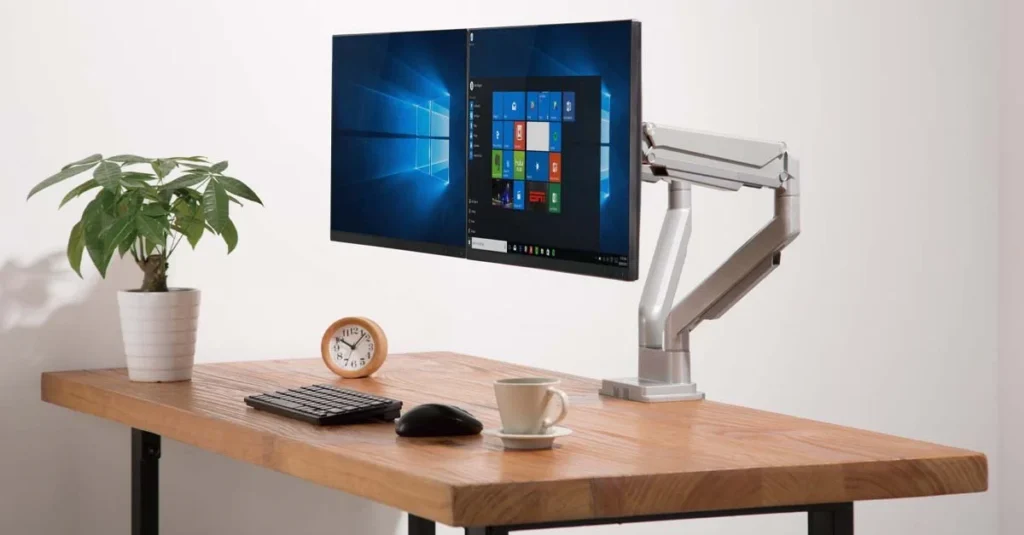In the digital age, where remote work and prolonged computer usage have become the norm, the importance of an ergonomic workstation cannot be overstated. One of the key components in setting up an ergonomic and efficient workspace is the computer monitor stand. This guide will delve into the benefits of using a computer monitor stand, essential features to look for, and tips for selecting the perfect stand to enhance your comfort and productivity.
Why You Need a Computer Monitor Stand
Improved Ergonomics
Proper ergonomics are crucial for maintaining comfort and preventing health issues associated with prolonged computer use, such as neck strain, back pain, and eye fatigue. A monitor stand allows you to position your screen at the correct height and angle, ensuring that the top of the screen is at or slightly below eye level. This alignment helps maintain a neutral neck position and reduces strain on your neck and shoulders.
Increased Desk Space
A monitor stand can significantly increase your available desk space by lifting your monitor off the desk. This creates additional room underneath for storage or organizing other essential items like a keyboard, mouse, or documents. A cleaner, more organized desk can boost productivity and reduce clutter-induced stress.
Enhanced Viewing Experience
Adjustable monitor stands provide flexibility in positioning your screen for optimal viewing. This is especially beneficial for multi-monitor setups, as it allows you to align your screens seamlessly. Improved screen positioning can enhance your viewing experience, making it easier to work on detailed tasks or consume media comfortably.
Versatility and Flexibility
Modern monitor stands come with various adjustment options, including height, tilt, swivel, and rotation. This versatility ensures that you can find the perfect viewing angle, whether you are working, gaming, or watching movies. Some stands even support portrait mode, which is ideal for coding, reading, or working on vertical content.
Key Features to Look for in a Computer Monitor Stand
Adjustable Height
Height adjustability is a crucial feature of a monitor stand. It allows you to set your monitor at the ideal eye level, reducing neck and eye strain. Look for stands that offer a wide range of height adjustments to accommodate different desk and chair heights.
Tilt and Swivel
A stand that allows you to tilt and swivel your monitor provides additional flexibility. Tilting helps reduce glare and reflections from overhead lighting, while swiveling makes it easier to share your screen with others or adjust your viewing position without moving the stand.
Weight Capacity
Ensure that the monitor stand you choose can support the weight of your monitor. Check the manufacturer’s specifications for the weight capacity and compare it with the weight of your monitor. Using a stand that cannot handle your monitor’s weight can lead to instability and potential damage to your equipment.
Build Quality
The material and construction of the monitor stand are important for durability and stability. Look for stands made from sturdy materials like metal or high-quality plastic. A well-built stand will provide a stable platform for your monitor and withstand daily use.
Cable Management
Integrated cable management features help keep your workspace tidy by organizing and hiding your monitor cables. This not only improves the aesthetics of your setup but also prevents cable tangling and damage.
Compatibility
Ensure that the monitor stand is compatible with your monitor’s size and VESA mounting pattern. Most monitors come with VESA mounting holes on the back, which are standardized for easy attachment to stands and mounts. Check the VESA pattern size and compare it with the stand’s specifications.
Types of Computer Monitor Stands
Freestanding Stands
Freestanding monitor stands sit on your desk and provide height and angle adjustments. They are easy to set up and move, making them a versatile option for different work environments. However, they occupy desk space, which might be a concern for smaller desks.
Desk-Mounted Stands
Desk-mounted stands, also known as clamp or grommet stands, attach to the edge of your desk or through a grommet hole. These stands save desk space and provide a stable and adjustable platform for your monitor. They are ideal for multi-monitor setups and can support heavier monitors securely.
Monitor Arms
Monitor arms offer the highest level of adjustability and flexibility. They attach to your desk and allow you to position your monitor in virtually any orientation, including height, depth, tilt, swivel, and rotation adjustments. Monitor arms are excellent for dynamic work environments where you need to frequently adjust your monitor’s position.
Riser Stands
Riser stands are simple platforms that elevate your monitor to eye level. They often come with additional storage space underneath for organizing office supplies. While they lack the advanced adjustability of other stands, riser stands are a cost-effective solution for improving ergonomics.
Tips for Choosing the Right Monitor Stand
Assess Your Needs
Consider your specific needs and how you use your monitor. If you frequently adjust your monitor’s position, a monitor arm with full adjustability might be the best choice. For a more static setup, a freestanding or riser stand might suffice.
Measure Your Desk Space
Ensure that the stand you choose fits comfortably on your desk and provides enough clearance for other items. Measure the dimensions of your desk and the space available for the stand to avoid overcrowding.
Read Reviews and Ratings
Customer reviews and ratings can provide valuable insights into the performance and reliability of different monitor stands. Look for products with consistently high ratings and positive feedback regarding stability, ease of use, and durability.
Consider Aesthetics
Choose a monitor stand that complements the design of your workspace. A well-designed stand can enhance the overall look of your desk and contribute to a more pleasant working environment.
Conclusion
A computer monitor stand is a vital component of an ergonomic and efficient workspace. By improving ergonomics, increasing desk space, and enhancing your viewing experience, the right monitor stand can significantly boost your comfort and productivity. When selecting a monitor stand, consider factors such as adjustability, build quality, weight capacity, and compatibility. By taking the time to choose the right stand, you can create a more comfortable, organized, and efficient workspace that supports your daily activities.








